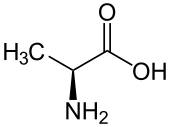Alanine facts for kids
Quick facts for kids Alanine |
|
|---|---|
 |
|
| IUPAC name | Alanine |
| Other names | 2-Aminopropanoic acid |
| Identifiers | |
| CAS number | |
| PubChem | |
| KEGG | C01401 |
| ChEBI | CHEBI:16977 |
| SMILES | O=C(O)C(N)C |
|
InChI
InChI=1/C3H7NO2/c1-2(4)3(5)6/h2H,4H2,1H3,(H,5,6)
|
|
| Properties | |
| Molecular formula | C3H7NO2 |
| Molar mass | 89.08 g mol-1 |
| Appearance | white powder |
| Density | 1.424 g/cm3 |
| Melting point |
258 °C, 531 K, 496 °F |
| Solubility in water | 167.2 g/L (25 °C) |
| log P | -0.68 |
| Acidity (pKa) |
|
| -50.5·10−6 cm3/mol | |
| Except where noted otherwise, data are given for materials in their standard state (at 25 °C, 100 kPa) | |
Alanine (abbreviated as Ala or A) is an α-amino acid. It has the chemical formula CH3CH(NH2)COOH.
The L-isomer is one of the 20 amino acids encoded by the genetic code. Its codons are GCU, GCC, GCA, and GCG. It is classified as a non-polar amino acid.
L-Alanine accounts for 7.8% of the primary structure in a sample of 1,150 proteins. Leucine is the only amino acid which is more common.
D-Alanine occurs in bacterial cell walls and in some peptide antibiotics.
Images for kids
See also
 In Spanish: Alanina para niños
In Spanish: Alanina para niños

All content from Kiddle encyclopedia articles (including the article images and facts) can be freely used under Attribution-ShareAlike license, unless stated otherwise. Cite this article:
Alanine Facts for Kids. Kiddle Encyclopedia.
